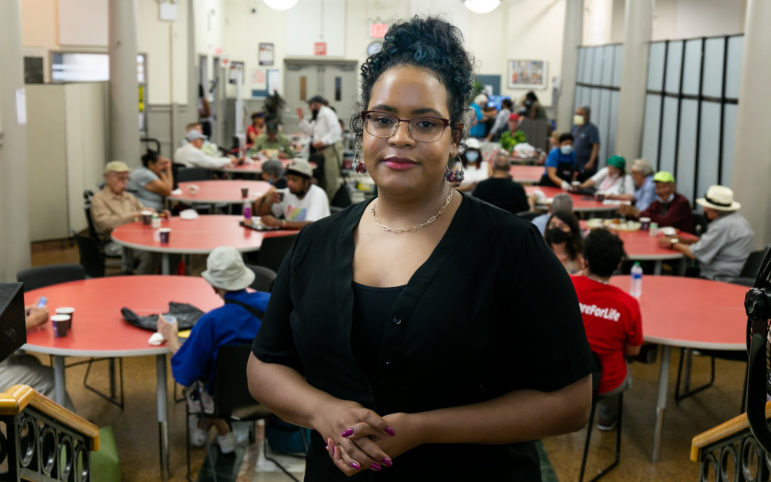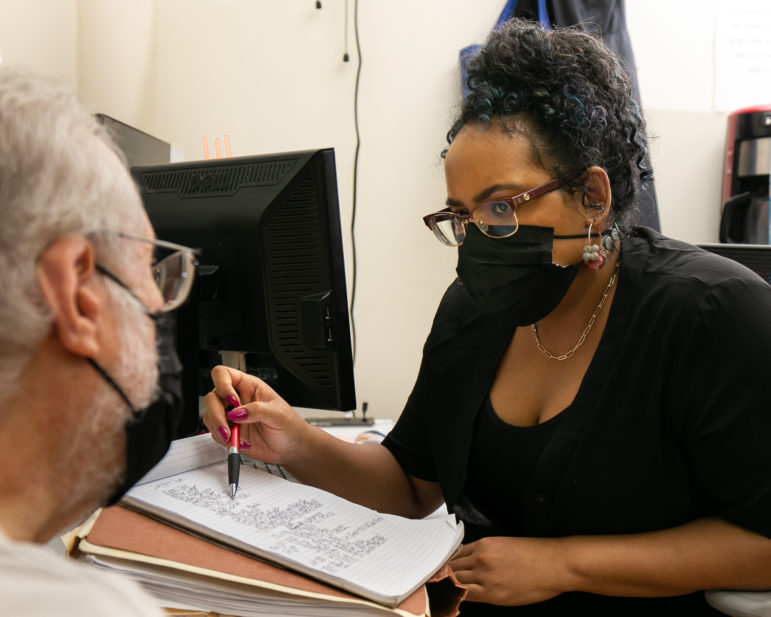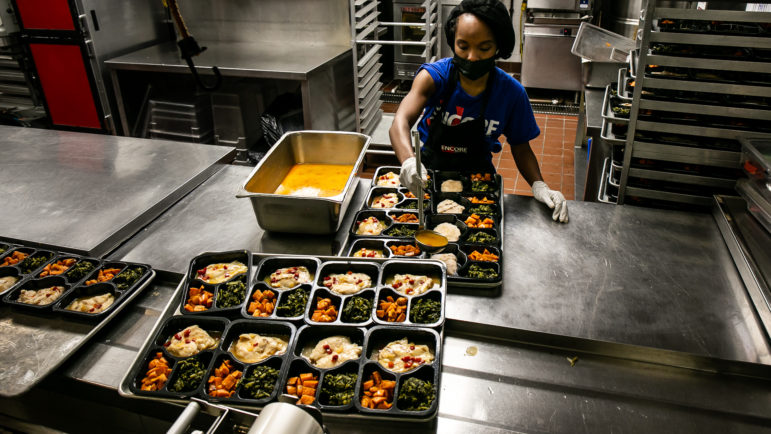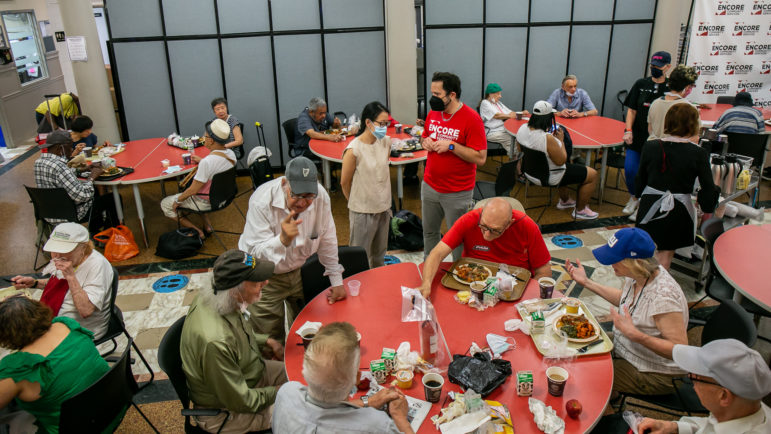Citywide, workers at nonprofits under contract to provide support and essential services to New Yorkers at a time of unprecedented crisis say they feel overworked, overwhelmed and burnt out. As costs continue to increase around them, many have said their low wages make it difficult to justify staying in the sector, even with a recent pay bump from the city and state.

Adi Talwar
Case Worker Andreina Salazar at Encore Community Services’ Senior Center on West 49th Street in Manhattan.Andreina Salazar’s desk at Encore Community Services on West 49th Street looks out to the senior center’s dining room. Between scheduled and walk-in appointments, she makes the rounds of the converted church basement to chat with her clients and other regulars who come in for the free lunches and sense of community.
But Salazar thinks about leaving the sector often. Every day, perhaps. And it’s not because she doesn’t like her job—as a case worker for older adults, she has purpose, she gets along well with “her” seniors, she takes care of them and they trust her. Rather, she says it’s the hours, the workload and the pay.
“It’s a lot. It’s back to back. And it means a lot of sacrifice on your behalf,” Salazar, 31, said. “It’s very difficult to provide services to others if you’re not compensated enough for the job that you do.”
Citywide, human service workers at nonprofits under contract to provide support and essential services to New Yorkers at a time of unprecedented crisis say they feel overworked, overwhelmed and burnt out. As costs continue to increase around them, many have said their low wages make it difficult to justify staying in the sector. At the same time, the city’s economic recovery has lagged, burdened by unemployment and inflation, increasing demand for social services and adding pressure to these already overburdened workers.
New York City contracts many of its social services—homelessness and housing assistance, foster care, youth, elder care, mental health, among others—to nonprofits. In the Fiscal Year (FY) 2022 budget, the city had nearly 4,600 contracts with human services organizations providing $5.6 billion in services, according to a March 2022 report by the New School’s Center for New York City Affairs. The sector employed over 80,000 workers, predominantly women and people of color, the same report found.
This year, both the city and state budgets included funding for Cost-of-Living-Adjustments (COLA) to boost the wages for contracted workers: $60 million in the city’s FY2023 Budget, the first such increase since before COVID, and $500 million in the state’s budget for the first time in a decade. This will essentially amount to 4 and 5.4 percent pay raises for city and state employees respectively, according to industry experts.
But two months after the city’s budget was signed, there is still no clear indication of how the money will be distributed. On the state level, agencies have begun disbursing the COLA to eligible programs, according to a spokesperson for governor. “Due to the variety of ways these organizations are paid, some programs began receiving the increases as early as April, while others—such as providers that are reimbursed through Medicaid rates—are still in development,” Gov. Kathy Hochul’s office said in a statement.
Even with the pay bump, advocates and workers worry it’s not enough to counteract the stresses from pandemic work and damage done by years of chronic underfunding which they say has left many nonprofits, and this workforce, on the cusp of a crisis.
“It’s still remarkably low, but it’s a huge step in the right direction,” said Michelle Jackson, executive director of the Human Services Council.
Human service workers make between 20 and 35 percent less in median wages than comparable positions in the public or private sector, with an average annual pay of $34,000. According to the New School report, about two-thirds of the city’s full-time human services workers had 2019 earnings below the near-poverty threshold.
“Government is the predominant funder of nonprofit human services; that also means they’re the predominant setter of wages,” Jackson added. “But there’s really been a divestment in the sector and it’s been borne on the backs of the workforce. Even before the pandemic, we were really on the brink of a workforce crisis, and it was becoming more and more apparent.”
Tight budgets made tighter
Workers now find themselves having to make their paychecks stretch. They worry about rent, food for themselves and their families, debt and student loans, all amid record inflation.
Salazar, who’s been living with her mother to save on some expenses, said she’s still struggling to support herself. She estimates her student loans from pursuing a graduate degree in social work to be around $50,000, but she hasn’t been able to afford making those payments since the onset of the pandemic.
Even now, with a salary around $45,000, she’s had to apply for similar government aid as her clients, like emergency rental assistance. Like many New Yorkers, she’s also had to grapple with rising food costs—which are up by about 9 percent since last year because of inflation—while earning too much to qualify for assistance like SNAP.

Adi Talwar
Case worker Andreina Salazar helping Lawrence Olin at Encore Community Services’ Senior Center.Elizabeth Marte, 27, recently left her position as a case manager at a BronxWorks family shelter because she worried about not being able to pay rent on her $45,000 a year salary. She said the stress of constantly worrying about her own stability affected her work, which included providing support to families and children in the shelter.
“It’s unfair, not only to [us] but to the clients,” Marte said “For me to be able to give them a hundred percent of me all the time, and due diligence, I need also not to worry whether or not I’m gonna be in shelter one day because I’m not being paid enough.”
She now works as a case manager at St. Ann’s Corner of Harm Reduction making $5,000 more, with the potential for an increase after her probationary period. In a statement, her former employer acknowledged the issue.
“Retention is an enormous challenge for organizations across the city’s human services sector because of the low rates providers get for city-contracted work. For this reason, BronxWorks has advocated for improved pay equity for years,” the organization’s director, Eileen Torres, told City Limits. “We are looking forward to seeing the details of how this year’s budget increase will be distributed to nonprofits, because we absolutely need to be able to pay more to the workers providing our communities with essential services.”
Not being able to offer competitive wages and raises has made retaining staff and hiring new people difficult sector-wide. Monique Williams, a clinical supervisor at Children’s Village, which provides support for young adults aging out of foster care, said she lost all four therapists on her team since the beginning of 2022. She has had to take over their responsibilities while trying to hire new people, despite not being able to offer higher salaries than in 2019.
“You hear people say, ‘I really would love to stay here. Do you think I could get an increase of $2,000 or $3,000?’ And we’re having to say ‘Unfortunately, no. Even though you’ve been doing this work for two years, we’re unable to give you an increase,’” said Williams.
“They just had to choose different paths to ensure that they could live. Because what we’ve been experiencing now are employees who are needing the same services that they’re working with their clients to receive.”
The ripple effect
The frequent staff turnover also negatively impacts the care these workers are able to provide.
Amarilis Soler, assistant vice president for Acacia Network Housing, which operates supportive housing and homeless shelters, said the inability to provide competitive wages for staff—from residential aids and security, to case managers and social workers—burdens not only other workers left with larger case loads but also their clients: families looking for stability as they enter the shelter system.
“Just entering the shelter system is traumatic enough. Having staff that they can relate to on an ongoing, consistent basis and building that rapport, establishing that trust level and a good relationship, is all part of the package of how successful we can be,” Soler said.
“So if the person [a client] finally developed a trusting relationship with was there for four or five or six months, and then [they] have to start all over again with a brand new person, they feel like, ‘Oh my gosh, I’m starting all over again. I have to tell you my story. I have to recount my trauma,’” she explained. “It all has an impact.”
Executives and staff at nonprofits citywide spoke of the contradiction between how local government leaders spoke of their sector during the pandemic, praising them as “essential workers” who kept the city’s local safety net operating, with the reality of how the government compensates them. Demand for social services provided by nonprofit workers has ballooned since the pandemic hit as New Yorkers struggle with the economic and emotional toll of the crisis.
“This is the work that the city of New York has asked us to do,” said Jeremy Kohomban, executive director at Children’s Village and Harlem Dowling, another child welfare nonprofit.
“We’re talking about a workforce that did not go remote. We were taking care of the children, the elder, the infirm, the disabled. It’s a workforce that until recently was considered essential, and was praised. And it’s a workforce that has actually experienced a real wage decline since the pandemic because of inflation,” Kohomban said.
It’s not just social workers and case managers struggling with these issues. Jeremy Kaplan, Encore’s executive director, pointed to the work that his lead driver for home-delivered meals for older adults does on a daily basis: walking one of his homebound seniors around the block in their wheelchair for some fresh air, or carrying another of his regulars up five flights of stairs—a woman who’d been waiting for him in her lobby, worried she’d miss the delivery because of her broken buzzer, who then needed help getting back up to her apartment.
“He’s not just delivering meals. He’s the only human contact that many of these people are gonna see. He cares about them. He’s caring for them and I can barely pay him a little bit above minimum wage,” Kaplan said. “And if he left, it would be so hard for me to fill that position with somebody who does what he does with as much care as he does.”
Since the onset of COVID, Kohombam and Kaplan’s organizations have respectively set floor wages for their employees and base salaries based on responsibilities and education. They’ve also implemented their own COLAs to better be able to retain staff.
Both hope the budgetary investments will bring about more changes to the sector, as will the city’s commitments to improving its contracting and procurement process outlined in a joint report between Mayor Adams’ and Comptroller Brad Lander. In July, the city said it had paid out more than $4.2 billion in contractual dollars since May, part of an effort to speed up payments to waiting nonprofits.
Whereas the COLA can begin to address the impacts of COVID and inflation, another long term solution towards closing the gap would be to establish a wage floor of $21 for all city-and-state-funded human service workers, some advocates say.
“Do people who care for your aging relatives and the people who help your children after school, don’t you think they deserve to live in the city and make enough money to have an apartment?” said Jackson, from the Human Services Council.
“I think the model of how people look at nonprofits needs to change. And that has to start with government recognizing that we’re an industry that the city relies on, not just for our humanitarian needs, but for our economic viability,” she added. “And one of the best things we can do for our economy is pay those workers a fair wage to do work.”
Meanwhile, the need for social services in New York City continues unabated. Evictions have increased steadily this year, as has the number of New Yorkers entering the homeless shelter system. Youth across the city and state are experiencing an ongoing mental health crisis and shortage of providers.
At the same time, several social safety net programs launched during the pandemic to keep New Yorkers afloat have expired, including the city’s emergency food distribution service, the expanded child income tax credit as well as several federal unemployment and pandemic aid programs.
“I’m having an influx of clients that I didn’t have before,” Salazar said. And yet she’s also seen more of her peers leave the sector in search of more stability.
“For a long time, I was the only case worker here,” she said. “We’ve seen a lot of people continue to leave the human services industry, and then who will do the work? If I’m feeling burnt out, then who else will come into my job? What will happen to our clients?”












2 thoughts on “Amid Inflation and Increased Demand, Human Services Workers Struggle with Burnout”
I really appreciate this well written article, as I am also a human service worker. I also have collaborated with Encore Meals on Wheels Coordinators on behalf of some of the older adults that I worked with in the past. They do excellent work. Ms. Salazar and all Encore workers need to become unionized. I found Mr. Kaplan’s comments interesting because he did not mention that they use a lot of volunteers to deliver the meals. They received millions of dollars for the meals on wheels program and could afford to allocate more funds to pay people a livable wage.
Selfhelp Community Service which works with Encore to deliver meals to seniors on the Westside of Manhattan brought in about 100 million dollars in revenue in 2021. Mr. Stuart Kaplan the CEO earned $696,000. Check out the Propublica.org website (https://projects.propublica.org/nonprofits/organizations/131624178)) to find out how much these nonprofit CEOs earn compared to their front-line essential workers. Nonprofit human services workers unite.
I know there will be some organizations that can meet the requirements of human services workers, but the number is too small. Mary had a good share as a person doing this job.